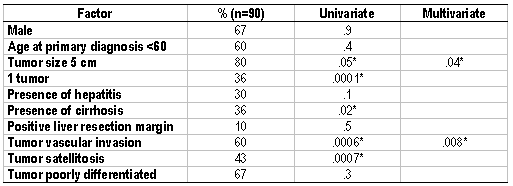# 100393 Abstract ID: 100393 Resection for Hepatocellular Carcinoma: Predictors of Recurrence and Analysis of Subsequent Post-Recurrence Survival
Charles Cha, Yuman Fong, William R Jarnagin, Leslie H Blumgart, Ronald P Dematteo, New York, NY
Introduction: Despite complete surgical resection, the majority of patients with hepatocellular carcinoma develop tumor recurrence. The objective of this study is to determine the patterns and predictors of first recurrence after resection of hepatocellular carcinoma at a Western institution. Methods: From February 1990 to May 2001, 168 patients with hepatocellular carcinoma underwent hepatectomy at our institution and were followed prospectively. Time to recurrence and survival after recurrence were determined by Kaplan-Meier analysis. Patient, tumor and treatment characteristics were tested for their prognostic significance by univariate and multivariate analysis using log rank and the Cox proportional hazards model, respectively. Results: The median age was 64 (21-87) years with 106 (65%) males. After a median follow up of 22 months (26 months for survivors), 90 patients (55%) have developed recurrent disease. Of them, there were 75 (83%) patients who recurred in the liver and this was the only site of disease in 65 (72%). There were only 15 (20%) patients with extrahepatic disease (7 lung, 4 peritoneum, 2 pancreas, 1 bone, and 1 brain). The median time to recurrence was 24 (1-274) months. Predictors of recurrence on univariate analysis were tumor size >5 cm, >1 tumor, cirrhosis, vascular invasion (microscopic or macroscopic), and tumor satellites (Table). On multivariate analysis, tumor size >5 cm (p=.04), and vascular invasion (p=.008) predicted recurrence. The median survival after recurrence (SAR) was 10 (0-60) months. Of the 90 patients who recurred, 56 (62%) were able to undergo additional ablative/surgical therapy (33 embolization, 9 ethanol injection, and 14 re-resection). On multivariate analysis, SAR was predicted by the ability to undergo additional treatment (median SAR of 17 months) and disease free interval >1 year (median SAR of 19 months). Conclusions: The liver is the predominant location of first recurrence after resection of hepatocellular carcinoma and these patients appear to benefit from liver directed therapy. The data suggest a potential role for regional adjuvant therapy in hepatocellular carcinoma.

|
 500 Cummings Center
500 Cummings Center +1 978-927-8330
+1 978-927-8330
 +1 978-524-0461
+1 978-524-0461